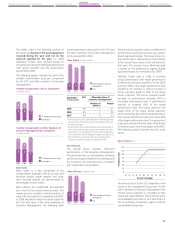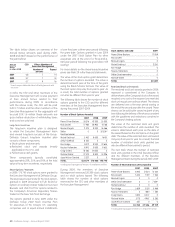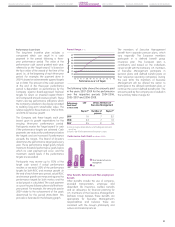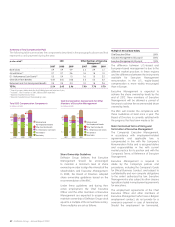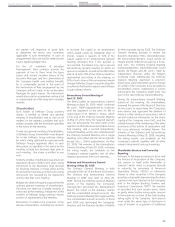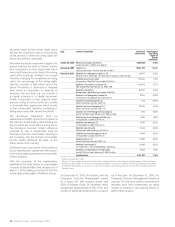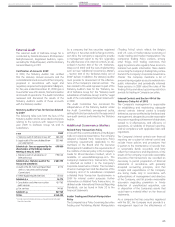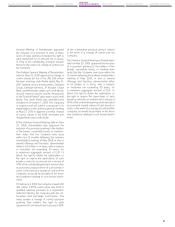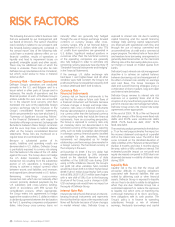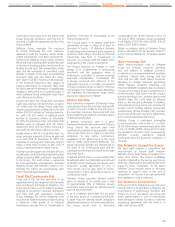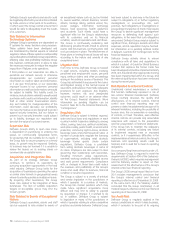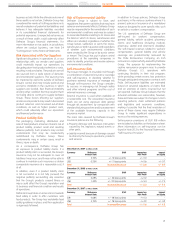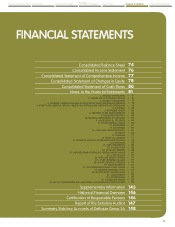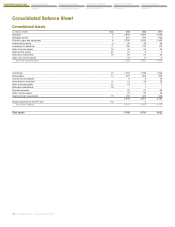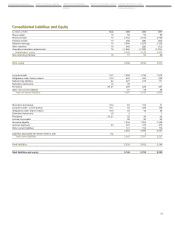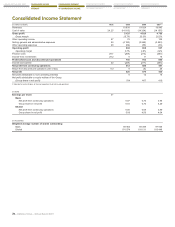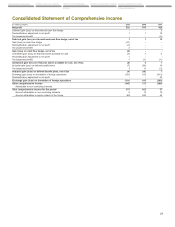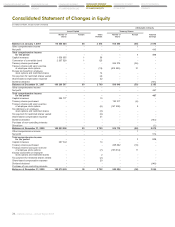Food Lion 2009 Annual Report Download - page 72
Download and view the complete annual report
Please find page 72 of the 2009 Food Lion annual report below. You can navigate through the pages in the report by either clicking on the pages listed below, or by using the keyword search tool below to find specific information within the annual report.
68 - Delhaize Group - Annual Report 2009
RISK FACTORS
The following discussion reflects business risks
that are evaluated by our management and
our Board of Directors. This section should be
read carefully in relation to our prospects and
the forward-looking statements contained in
this annual report. Any of the following risks
could have a material adverse effect on our
financial condition, results of operations or
liquidity and lead to impairment losses on
goodwill, intangible assets and other assets.
There may be additional risks of which the
Group is unaware. There may also be risks
Delhaize Group now believes to be immaterial,
but which could evolve to have a material
adverse effect.
Currency Risk – Business Operations
Delhaize Group’s operations are conducted
primarily in the U.S. and Belgium and to a
lesser extent in other parts of Europe and in
Indonesia. The results of operations and the
financial position of each of Delhaize Group’s
entities outside the euro zone are accounted
for in the relevant local currency and then
translated into euro at the applicable foreign
currency exchange rate for inclusion in the
Group’s consolidated financial statements,
which are presented in euro (see also Note 2.3
”Summary of Significant Accounting Policies”
in the Financial Statements with respect to
translation of foreign currencies). Exchange rate
fluctuations between these foreign currencies
and the euro may have a material adverse
effect on the Group’s consolidated financial
statements. These risks are monitored on a
regular basis at a centralized level.
Because a substantial portion of its
assets, liabilities and operating results are
denominated in U.S. dollars, Delhaize Group
is particularly exposed to currency risk arising
from fluctuations in the value of the U.S. dollar
against the euro. The Group does not hedge
the U.S. dollar translation exposure. The
transaction risk resulting from the substantial
portion of U.S. operations is managed by
striving to achieve a natural currency offset
between assets and liabilities and revenues
and expenditures denominated in U.S. dollars.
Remaining intra-Group cross-currency
transaction risks which are not naturally offset
concern primarily dividend payments by the
U.S. subsidiary and cross-currency lending,
which in accordance with IFRS survive the
consolidation process. When appropriate,
the Group enters into agreements to hedge
against the variation in the U.S. dollar in relation
to dividend payments between the declaration
by the U.S. operating companies and payment
dates. Intra-Group cross-currency loans not
naturally offset are generally fully hedged
through the use of foreign exchange forward
contracts or currency swaps. After cross-
currency swaps, 87% of net financial debt is
denominated in U.S. dollars while also 77%
of profits from operations are generated in
U.S. dollars. Significant residual positions in
currencies other than the functional currency
of the operating companies are generally
also fully hedged in order to eliminate any
remaining currency exposure (see also Note 19
”Derivative Financial Instruments and Hedging”
in the Financial Statements).
If the average U.S. dollar exchange rate
had been 1 cent higher/lower and all other
variables were held constant, the Group’s net
profit would have increased/decreased by EUR
3 million (2008 and 2007: EUR 2 million).
Currency Risk –
Financial Instruments
Currency risk on financial instruments is the
risk that the fair value or future cash flows of
a financial instrument will fluctuate because
of future changes in foreign exchange rates.
Currency risks arise on financial instruments
that are denominated in a foreign currency, i.e.
in a currency other than the functional currency
of the reporting entity that holds the financial
instruments. From an accounting perspective,
the Group is exposed to currency risks only
on monetary items not denominated in the
functional currency of the respective reporting
entity, such as trade receivables denominated
in a foreign currency, financial assets classified
as available for sale, derivatives, financial
instruments not designated as for hedge
relationships and borrowings denominated in
a foreign currency. The functional currency of
the Company is the euro.
At December 31, 2009, if the U.S. dollar had
weakened/strengthened by 24% (estimate
based on the standard deviation of daily
volatilities of the EUR/USD rate during 2009
using a 95% confidence interval), the Group’s
net profit (all other variables held constant)
would have been EUR 3.4 million higher/lower
(2008: EUR 0.1 million lower/higher with a rate
shift of 28%; 2007: EUR 2.1 million lower/higher
with a rate shift of 12%). Due to the financing
structure of the Group, such a change in EUR/
USD exchange rate would have no impact on
the equity of Delhaize Group.
Interest Rate Risk
Interest rate risk is the risk that arises on interest-
bearing financial instruments and represents
the risk that the fair value or the expected cash
flows will fluctuate because of future changes
in market interest rates. Delhaize Group is
exposed to interest rate risk due to working
capital financing and the overall financing
strategy. Daily working capital requirements
are financed with operational cash flow and
through the use of various committed and
uncommitted lines of credit and a commercial
paper program. The interest rate on these short
and medium term borrowing arrangements is
generally determined either as the inter-bank
offering rate at the borrowing date plus a pre-
set margin or based on market quotes from
banks.
Delhaize Group’s interest rate risk management
objective is to achieve an optimal balance
between borrowing cost and management of
the effect of interest rate volatility on earnings
and cash flows. The Group manages its
debt and overall financing strategies using a
combination of short, medium, long-term debt
and interest rate derivatives.
Delhaize Group reviews its interest rate risk
exposure on a quarterly basis and at the
inception of any new financing operation. As a
part of its interest rate risk management efforts,
Delhaize Group enters into interest rate swap
agreements when appropriate.
At the end of 2009, 79.1% of the net financial
debt after swaps of the Group were fixed-rate
debts and 20.9% were variable-rate debts
(2008: 79.2% fixed-rate debt; 2007: 74.7%
fixed-rate debt).
The sensitivity analysis presented in the table on
p. 71 on the next page estimates the impact on
the income statement and equity of a parallel
shift in the interest rate curve. The shift in that
curve is based on the standard deviation of
daily volatilities of the ”Reference Interest Rates”
(Euribor 3 months and Libor 3 months) during
the year, within a 95% confidence interval. The
estimated possible impact on net profit and
equity decreased compared to 2008 due to an
observed decrease in volatility of interest rates
during 2009.
Liquidity Risk
Liquidity risk is the risk that the Group will
encounter difficulty in meeting obligations
associated with financial liabilities that are
settled by delivering cash or other financial
assets. Delhaize Group is exposed to liquidity
risk as it has to be able to satisfy its obligations
when they are due. Delhaize Group has a
centralized approach to reduce the exposure
to liquidity risk which aims at matching the
contractual maturities of its short- and long-
term obligations with its cash position. The
Group’s policy is to finance its operating
subsidiaries through a mix of retained
earnings, third-party borrowings and capital



